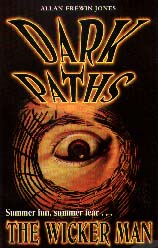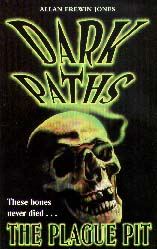|
________________
CM . . . .
Volume V Number 14 . . . . March 12, 1999
excerpt: The Wicker Man
Frankie looked at the others. 'We were thinking of coming along to watch,' she said. 'But do you mean we could actually join in?'Plague Pit
Jack flipped over the pages of his notebook. 'Oh yes,' he said, 'here's something really interesting. Like for instance did you know that the nursery rhyme "Ring a ring o' roses" is all to do with the plague?'These two books, the first of the "Dark Paths" series, are another attempt to take advantage of the present popularity of the horror story. Their starting point is a group of four adolescents, all of whom belong to their school's archeological club (known for some unexplained reason as ACE---Archeological Club Extraordinaire?). This is their "in" at digs in the vicinity of their English town, and initiates their adventures. In The Wicker Man, the excavation finds the remains of a horse which had been the sacrificial victim at an Iron Age Celtic festival for May Day, or Beltane. This desecration appears to anger the gods, and at least two of the townspeople feel that appeasement is only possible if a real human sacrifice is included the modern re-enactment of the festival. And one of the four friends is chosen to be that sacrifice. The Plague Pit comes closer to our own times, with the accidental opening of a pit where the bodies of victims of the Great Plague of the seventeenth century have been hastily buried. Included among the dead was the body of a doctor who had played on the fears of his rich fellow villagers, giving them a "cure" which instead actively infected them so that the doctor could steal their effects. Again the opening of the site meant that the spirit of evil was freed to roam and our four friends were in the way. Digging up the past is a good excuse for telling the reader all about it, and the books do this rather well. By having spirits of earlier times haunting the present, whether they take over one of the children, or someone else, or both, the author can introduce a lot of history in very exciting, palatable, form. The facts are not stored in separate paragraphs labelled "Skip me" to the sharp eye of the fiction lover but are seamlessly blended into the story line. The short "Afterword" of condensed history encapsulates the background information usefully enough that it might turn up in a school project. Certainly the history as presented could well stimulate interest in the period in question. After the opening chapter, which, rather in the style of the old Nancy Drew mysteries of my childhood, gives all the names, ages, essential physical features, and distinguishing characteristics of the protagonists, the stories begin rather well. The archaeological background is interesting, and things start to happen right away. Tensions build, the plot develops and deepens satisfactorily, but the endings are a bit of letdown. Having a girl infected by the spirit of the evil doctor suddenly split into two persons, herself and the doctor, when threatened by an 11-year-old wielding a cricket bat does resolve the action, but strains credulity. The stories stretch other limits as well. The American slang used by one youngster is outlandish "to the max," and the thought of one of these children managing to wade through two years of Pepy's diaries in the course of an afternoon, searching out references to the plague is mind boggling. But the stories are interesting, their backgrounds are authentic and seem pretty accurate, and so, on the whole, I think this series is worth a read. There will be lots of opportunities---four more volumes are scheduled to appear by July 1999! Recommended with Reservations (The Wicker Man). Mary Thomas is taking a busman's holiday, working in the library at Oxford Brookes University while on leave from elementary-school libraries in Winnipeg.
To comment on this title or this review, send mail to cm@umanitoba.ca.
Copyright © the Manitoba Library Association.
Reproduction for personal use is permitted only if this copyright notice
is maintained. Any other reproduction is prohibited without
permission.
Published by
TABLE OF CONTENTS FOR THIS ISSUE - MARCH 12, 1999.
SEARCH |
AUTHORS |
TITLES |
MULTIMEDIA |
PROFILES |
BACK ISSUES |
CMARCHIVE |
HOME
|


